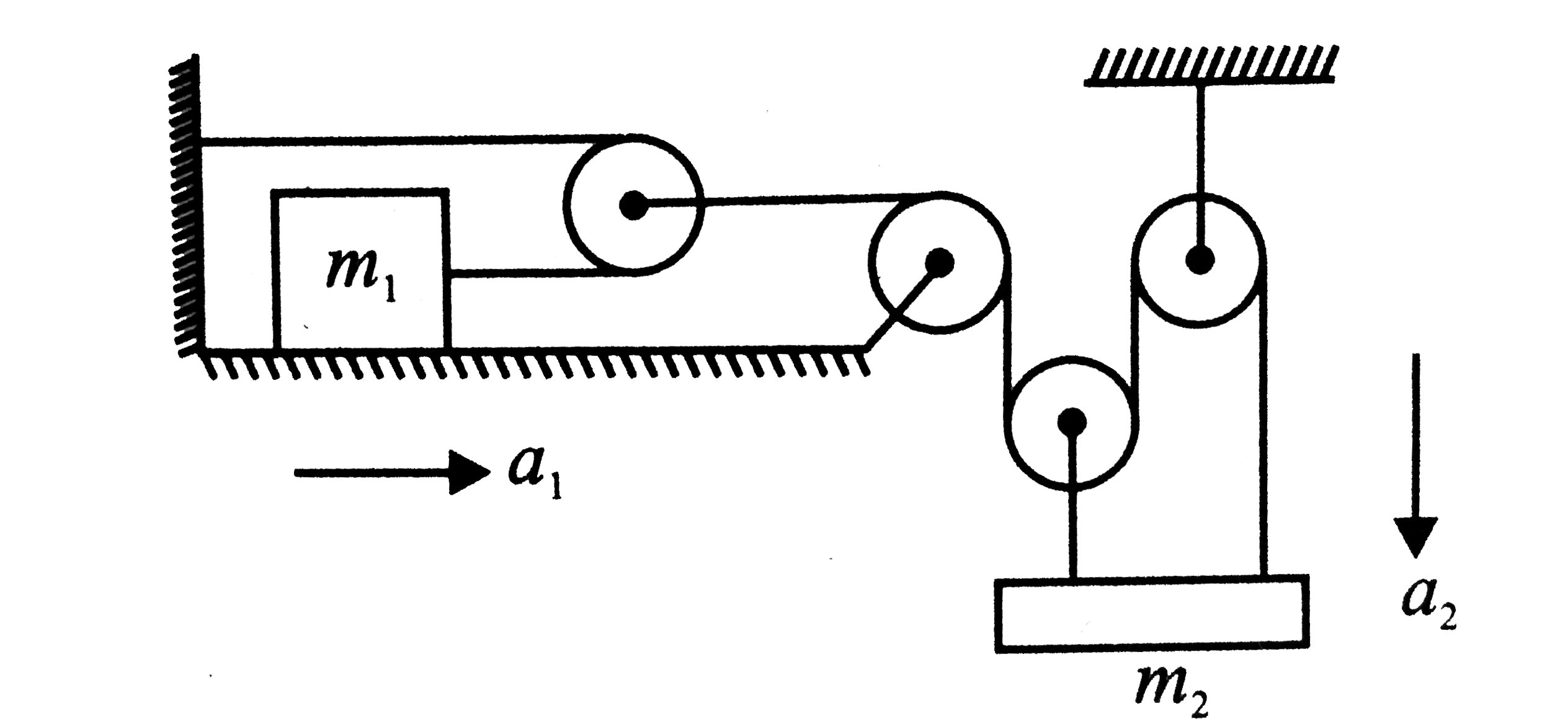Find the acceleration of 3kg mass when acceleration of 2kg mass is ms−2 as shwon in fig.

From force diagram of 2-kg block:

10−kx=2a=4
∴kx=6
From force diagram of 3kg block,
kx=3a
or 6=3a
∴a=63=2ms−2.
Topper's Solved these Questions
- NEWTON'S LAWS OF MOTION 1BOOK - CENGAGE PHYSICS ENGLISHCHAPTER - NEWTON'S LAWS OF MOTION 1EXERCISE - Subjective
15 Videos
- NEWTON'S LAWS OF MOTION 1BOOK - CENGAGE PHYSICS ENGLISHCHAPTER - NEWTON'S LAWS OF MOTION 1EXERCISE - Single Correct
73 Videos
- NEWTON'S LAWS OF MOTION 1BOOK - CENGAGE PHYSICS ENGLISHCHAPTER - NEWTON'S LAWS OF MOTION 1EXERCISE - Exercise 6.3
19 Videos
- MISCELLANEOUS VOLUME 2BOOK - CENGAGE PHYSICS ENGLISHCHAPTER - MISCELLANEOUS VOLUME 2EXERCISE - INTEGER_TYPE
10 Videos
- NEWTON'S LAWS OF MOTION 2BOOK - CENGAGE PHYSICS ENGLISHCHAPTER - NEWTON'S LAWS OF MOTION 2EXERCISE - Integer type
1 Video
Similar Questions
A hot- air balloon consists of a basket, one passenger, and some carge. Let the total mass be M. Even though there is an upward lift force on the balloon, the balloon is initially acceleration downwards at a rate of g/3.
(a) Draw a free-body diagram for the descending balloon.
(b) Find the upward lift force in terms of the initial total weight Mg.
(c ) The passenger notices that he is heading straight for a waterfall and decides he needs to go up. What fraction of the total weight must he drop overboard so that the balloon accelerates upward at a rate of g/2? Assume that the upward lift force remains the same.
View SolutionTwo skaters have weight in the ratio 4:5 and are 9m apart, on a smooth frictionless surface. They pull on a rope stretched between them. The ratio of the distance covered by them when they meet each other will be
View SolutionBlock A is given an acceleration 12ms−2 towards left as shown in fig. Assuming block B always remains horizontal, find the acceleration (in ms−2) of B.

View SolutionTwo blocks are arranged as shown in figure. Find the ratio of a1/a2. (a1 is acceleration of m1 and a2 that of m2)

View SolutionA block is moving on an inclined plane making an angle 45∘ with the horizontal and the coefficient of friction is μ. The force required to just push it up the inclined plane is 3 times the force required to just prevent it from sliding down. If we define N=10μ, then N is
View SolutionIn the adjacent figure, masses of A,B and C are 1kg,3kg and 2kg respectively. Find
(a) the acceleration of the system and
(b) tension in the strings.
Neglect friction.(g=10m/s2)

View SolutionFind the relation in the accelerations of the three masses shown in fig.
View SolutionFind the acceleration of 3kg mass when acceleration of 2kg mass is ms^(-2) as shwon in fig.
View SolutionThree sperical balls of masses 1kg, 2kg and 3kg are placed at the corners of an equilateral triangle of side 1m. Find the magnitude of the gravitational force exerted by 2kg and 3kg masses on 1kg mass.
View SolutionIn the fig, find the acceleration of mass m_(2) .
View SolutionFind the acceleration of 3 kg mass when acceleration of 2 kg mass is 2ms^(-2) as shown in figure-2.140
View SolutionTwo particles of masses 2 kg and 4 kg are approaching each other with acceleration 1ms−2 and 2ms−2, respectively, on a smooth horizontal surface. Find the magnitude of acceleration of center of mass of the system.
View SolutionThree spherical balls of masses 1kg, 2kg and 3kg are placed at the corners of an equilateral triangle of side 1m. Find the magnitude of the gravitational force experted by the 2kg and 3kg masses on the 1kg mass.
View SolutionIn the adjacent fig, masses of A, B and C are 1 kg, 3kg and 2kg respectively. Find a) the acceleration of the system b) tension in the string (g=10m//s^(2))
View SolutionIn the fig, find the acceleration of mass m2
View Solutionकिसी 3Kg द्रव्यमान की एक बॉल में 2ms−2 का त्वरण उत्पन्न करने के लिए जितने बल की आवश्यकता होगी, वह है-
View Solution

